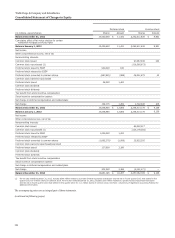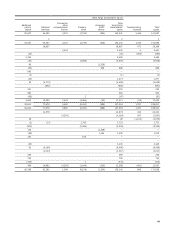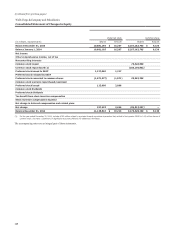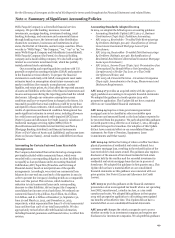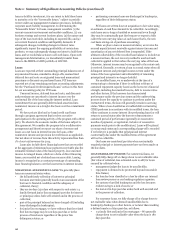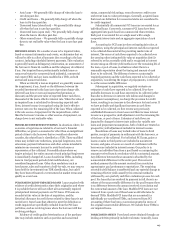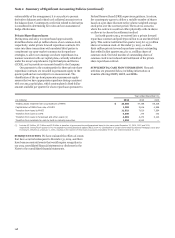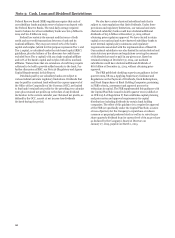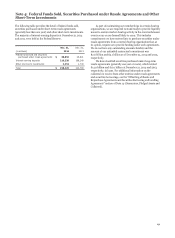Wells Fargo 2014 Annual Report Download - page 144
Download and view the complete annual report
Please find page 144 of the 2014 Wells Fargo annual report below. You can navigate through the pages in the report by either clicking on the pages listed below, or by using the keyword search tool below to find specific information within the annual report.Note 1: Summary of Significant Accounting Policies (continued)
loans as held for investment, it is our intent to hold these loans
to maturity or for the “foreseeable future,” subject to periodic
review under our management evaluation processes, including
corporate asset/liability management. In determining the
“foreseeable future” for loans, management considers (1) the
current economic environment and market conditions, (2) our
business strategy and current business plans, (3) the nature and
type of the loan receivable, including its expected life, and (4)
our current financial condition and liquidity demands. If
subsequent changes, including changes in interest rates
significantly impact the ongoing profitability of certain loan
products, we may subsequently change our intent to hold these
loans, and we would take actions to sell such loans. Upon such
management determination, we immediately transfer these
loans to the MHFS or LHFS portfolio at LOCOM.
Loans
Loans are reported at their outstanding principal balances net of
any unearned income, cumulative charge-offs, unamortized
deferred fees and costs on originated loans and unamortized
premiums or discounts on purchased loans. PCI loans are
reported net of any remaining purchase accounting adjustments.
See the “Purchased Credit-Impaired Loans” section in this Note
for our accounting policy for PCI loans.
Unearned income, deferred fees and costs, and discounts
and premiums are amortized to interest income over the
contractual life of the loan using the interest method. Loan
commitment fees are generally deferred and amortized into
noninterest income on a straight-line basis over the commitment
period.
We have private label and co-brand credit card loans
through a program agreement that involves our active
participation in the operating activity of the program with a third
party. We share in the economic results of the loans subject to
this agreement. We consider the program to be a collaborative
arrangement and therefore report our share of revenue and
losses on a net basis in interest income for loans, other
noninterest income and provision for credit losses as applicable.
Our net share of revenue from this activity represented less than
1% of our total revenues for 2014.
Loans also include direct financing leases that are recorded
at the aggregate of minimum lease payments receivable plus the
estimated residual value of the leased property, less unearned
income. Leveraged leases, which are a form of direct financing
leases, are recorded net of related non-recourse debt. Leasing
income is recognized as a constant percentage of outstanding
lease financing balances over the lease terms in interest income.
NONACCRUAL AND PAST DUE LOANS We generally place
loans on nonaccrual status when:
• the full and timely collection of interest or principal
becomes uncertain (generally based on an assessment of the
borrower’s financial condition and the adequacy of
collateral, if any);
• they are 90 days (120 days with respect to real estate 1-4
family first and junior lien mortgages) past due for interest
or principal, unless both well-secured and in the process of
collection;
• part of the principal balance has been charged off (including
loans discharged in bankruptcy);
• for junior lien mortgages, we have evidence that the related
first lien mortgage may be 120 days past due or in the
process of foreclosure regardless of the junior lien
delinquency status; or
• performing consumer loans are discharged in bankruptcy,
regardless of their delinquency status.
PCI loans are written down at acquisition to fair value using
an estimate of cash flows deemed to be collectible. Accordingly,
such loans are no longer classified as nonaccrual even though
they may be contractually past due because we expect to fully
collect the new carrying values of such loans (that is, the new
cost basis arising out of purchase accounting).
When we place a loan on nonaccrual status, we reverse the
accrued unpaid interest receivable against interest income and
amortization of any net deferred fees is suspended. If the
ultimate collectability of the recorded loan balance is in doubt on
a nonaccrual loan, the cost recovery method is used and cash
collected is applied to first reduce the carrying value of the loan.
Otherwise, interest income may be recognized to the extent cash
is received. Generally, we return a loan to accrual status when all
delinquent interest and principal become current under the
terms of the loan agreement and collectability of remaining
principal and interest is no longer doubtful.
For modified loans, we re-underwrite at the time of a
restructuring to determine if there is sufficient evidence of
sustained repayment capacity based on the borrower’s financial
strength, including documented income, debt to income ratios
and other factors. If the borrower has demonstrated
performance under the previous terms and the underwriting
process shows the capacity to continue to perform under the
restructured terms, the loan will generally remain in accruing
status. When a loan classified as a troubled debt restructuring
(TDR) performs in accordance with its modified terms, the loan
either continues to accrue interest (for performing loans) or will
return to accrual status after the borrower demonstrates a
sustained period of performance (generally six consecutive
months of payments, or equivalent, inclusive of consecutive
payments made prior to the modification). Loans will be placed
on nonaccrual status and a corresponding charge-off is recorded
if we believe it is probable that principal and interest
contractually due under the modified terms of the agreement
will not be collectible.
Our loans are considered past due when contractually
required principal or interest payments have not been made on
the due dates.
LOAN CHARGE-OFF POLICIES For commercial loans, we
generally fully charge off or charge down to net realizable value
(fair value of collateral, less estimated costs to sell) for loans
secured by collateral when:
• management judges the loan to be uncollectible;
• repayment is deemed to be protracted beyond reasonable
time frames;
• the loan has been classified as a loss by either our internal
loan review process or our banking regulatory agencies;
• the customer has filed bankruptcy and the loss becomes
evident owing to a lack of assets; or
• the loan is 180 days past due unless both well-secured and
in the process of collection.
For consumer loans, we fully charge off or charge down to
net realizable value when deemed uncollectible due to
bankruptcy discharge or other factors, or no later than reaching
a defined number of days past due, as follows:
• 1-4 family first and junior lien mortgages – We generally
charge down to net realizable value when the loan is 180
days past due.
142




